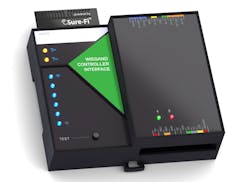First-time GSX exhibitor Q&A: Sure-Fi
The term “Guns, Guards and Gates” has become somewhat derogatory in many security circles. It has come denote people and organizations that still retain an old-school, and some would even say outdated mentality to how they approach things, including the various technologies that are at their disposal these days. The fact is, however, is that these things are still the cornerstones of many security programs and without them, some of the nation’s largest businesses and critical infrastructure sites would be left vulnerable to criminals and terrorists.
Just because guns, guards and gates make up the bulk of an organization’s security resources, doesn’t mean they can’t be improved upon from a technological perspective. Enter Sure-Fi which has created a radio-frequency (RF) solution that can eliminate the hassle and cost of trenching for gates and also potentially be used in other access control applications. The company, which is exhibiting for the first time this year at GSX (Booth # 2087), was recently recognized with a 2019 Innovative Product Award for its Serial Data Bridge solution.
Sure-Fi CEO Mark Hall initially came up with the idea for the technology about five years ago when he was the general manager of Novatek, an industrial diamond manufacturing and engineering services company. Knowing that the firm was in the long process of becoming acquired by their largest customer, Schlumberger, one of the world’s largest oil and gas services firms, Hall, along with his father, were in the midst of trying to come up with a plan to keep everyone at the company employed when Hall and his team of RF engineers set to work on developing the product that would eventually become Sure-Fi.
SecurityInfoWatch.com (SIW) caught up with Hall to discuss the story behind the company’s founding and what sets their RF technology apart in this GSX first-time exhibitor Q&A:
SIW: How was Sure-Fi developed and how does the technology work?
Hall: I had an idea that I wanted to get into my garage with my garage keypad using a phone and an app. I was really surprised I couldn’t find it. I could find keypads that existed and worked for the front door of a home but I could not find a garage keypad with PIN codes for my phone using an app. I challenged 500 employees in our company to find it because I felt like a fool that I couldn’t find it using Google and they all came back with the same answer: “We found it Mark; here is an app that can open the garage.” I said no, that’s not what I asked; I wanted a garage keypad that I could program remotely using my phone. So, nobody could find it and t didn’t exist.
We had some ideas around in-garage delivery and neat ideas that we wanted to implement for the future utilizing that and we discovered this was good for our RF group. Our reason for postulating it didn’t exist was because Wi-Fi is sketchy to your garage, it’s really difficult to get reliability right in front of your garage and I’m sure the concern of returns and reliability were enough to keep people away from doing it. We put our on RF team on it just to develop a regular 900 megahertz (solution) and we developed a garage keypad that did that and launched that product called TrackPIN. We deployed 2,000 units in the field but it was too expensive. People aren’t going to spend a lot of money on their garage and it didn’t succeed but in the process, we had many, many people come to us and say, “you know, gates are a huge problem and a big pain point because people are spending thousands, tens of thousands of dollars on trenching to get communication out to a gate.”
But we chewed on that and having failed with TrackPIN, we were fascinated with a transceiver made by Semtech that’s known as the LoRa transceiver today by many people… and once we got the LoRa transceiver and the various development kits with it, we discovered that there was some hope but what it said it could do and what it actually can/can’t do compared to what their spec and papers are were very different. We spent the next two years, 2015 and 2016, really developing our own proprietary modulation that worked with that transceiver and that’s where Sure-Fi was developed. That’s where we solved the gate problem and we launched a bridge product that allowed any gate to be retrofitted with Sure-Fi and/or new gate without the need to trench and that’s what really launched the company – the Wiegand wireless bridge. That’s been a great success.
What are Sure-Fi’s other applications for the security industry?
We’re developing products, bridges – wire replacements are really all they are – for HVAC, so thermostat wire replacement, of course, the Wiegand wire replacement for access control systems, a relay bridge in a few different formats, and we are working right now on serial data bridges for more advanced applications like audio that have lots of promise. We’re hoping that our name will get out there and that more and more people will use it and then, eventually, someone will have enough interest and confidence to actually implement our module directly into their application and we think access control will be the first one that does that.
Gates were low-hanging fruit, so to speak because it was a pain point, but that same product will work on any door. Pretty much 90% of the market is Wiegand communication protocol for access control and the remaining 10% are ODBC or serial-type data communications and we’ll have that product for that remaining 10% by the end of the year, so we will have two wire replacement products that cover all access control by the end of this year.
What is the range of your product?
It is one mile in a structure and 50 miles line of sight. We literally take range issues in a building environment off the table. We will do 25 to 30 stories in a skyscraper, so if you’re higher than 25 stories you might need to add one more box to repeat it. That’s an extreme environment, but we’re in warehouses that are well over one million square feet in size.
What do you see as being some of the biggest obstacles facing you in the marketplace?
Integrators have been waiting for reliable wireless for some time. In fact, that’s our biggest impediment; breaking through the doubt. When you say wireless in the access control world, the integrators get really jittery because they have been promised a lot for a long time. The honest truth is that our homes are unwired but industrial and commercial applications continue to be wired. If I’m building a brand new hospital today, it will be wired. There will be large bands of wire going into a control room - and when I say wire I really mean cable, primarily Cat 6 – in just massive bundles into control boxes.
Why are our homes unwired and these environments not? The answer is pretty simple: Wi-Fi is a residential-directed RF communication. In the industrial or utility-type of environment, they need 100% reliability. It can’t be a gadget that kind of works and we laugh it off like we’re used to at home, it has to work. That door has to open, the HVAC system has to work, they’re not messing around so they wire it for that reason. This is the first technology, in my opinion, that breaks that paradigm.
What’s your go-to-market strategy?
It is really simple. The integrators are hesitant to use wireless and we’re breaking that paradigm through wire replacement products that are primarily being implemented in retrofit applications. If I build a brand new hospital, who wants to take a chance on making it all unwired? Nobody is going to raise their hand for that one. But in situations where they just don’t want to use wire and do the gymnastics of bringing in a scissor lift and doing all of the wirings in a hospital, they’re using our product here and there and that’s our go-to-market strategy. It will start to develop confidence over time in the retrofit with these same integrators in our technology. This is not your father’s wireless. We break lots of paradigms.
Labor is the biggest issue for integrators. You’ve got access control that is growing at 8% to 12% annually and it has since 9/11. The new labor, the Millennials, they know how to do wireless and how to keyboard stuff, but none of them grow up wanting to get in a scissor lift or climb up and around in rafters doing wiring, so a lot of the rock star employees that have been doing this for decades end up redoing the work of the new employees. It is the story of this diminishing return that we hear over and over again from installers.
About the Author:
Joel Griffin is the Editor of SecurityInfoWatch.com and a veteran security journalist. You can reach him at [email protected].
About the Author
Joel Griffin
Editor-in-Chief, SecurityInfoWatch.com
Joel Griffin is the Editor-in-Chief of SecurityInfoWatch.com, a business-to-business news website published by Endeavor Business Media that covers all aspects of the physical security industry. Joel has covered the security industry since May 2008 when he first joined the site as assistant editor. Prior to SecurityInfoWatch, Joel worked as a staff reporter for two years at the Newton Citizen, a daily newspaper located in the suburban Atlanta city of Covington, Ga.

